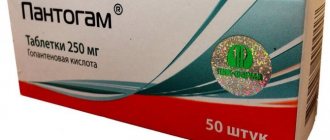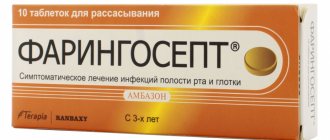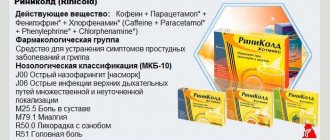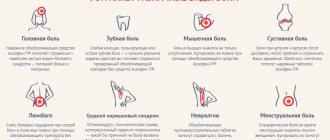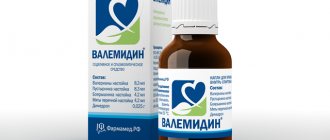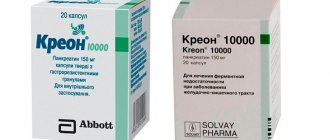Properties and dosage forms of the drug
Panadol is a non-narcotic analgesic that has antipyretic and analgesic effects. The drug contains the main active ingredient – paracetamol.
Mechanism of action
This chemical has the following effects on the human body:
Antipyretic. Antipyretics are a group of drugs that help relieve fever and high temperature due to their effect on the thermoregulation center in the brain - the hypothalamus. At the same time, paracetamol does not reduce body temperature below 36.6 degrees Celsius.- Analgesic. Pain relief occurs due to a decrease in the amount of special physiologically active substances from the group of unsaturated fatty acids - prostaglandins, which affect the sensitivity of nerve endings.
- Anti-inflammatory. This effect is weakly expressed, since the active component of the drug is destroyed by peroxidases - enzymes that utilize hydrogen peroxide in cells.
The mechanism of action of Panadol is to reduce the activity of the enzyme cyclooxygenase, as a result of which the body’s production of prostaglandins is inhibited, resulting in relaxation of the smooth muscles of internal organs. This effect is provided by the active substance – paracetamol. The medicine also contains additional auxiliary components.
The dosage of the drug is carried out depending on the patient’s age, the severity of symptoms, as well as the characteristics of his condition (for example, during pregnancy). The method of using Panadol depends on the dosage form. The product is available in several forms, the features of which will be discussed below.
Pills
They contain 500 mg of active substance. Most often they are used for people over 18 years of age. Depending on the method of administration and additional components, they are as follows:
- Pills.
- Active (sodium bicarbonate, contained additionally, promotes the absorption of paracetamol).
- Soluble (these are instant effervescent tablets packaged in laminated plates).
- Femina (contains additionally hyoscine butyl bromide, women drink it for menstrual pain, 10 tablets are released in a blister).
You need to take the tablets orally, swallowing them whole (no need to chew, crush, or dissolve them) and wash them down with liquid.
Before use, Panadol Soluble is dissolved in water and then drunk at a time. The dosage is determined by the doctor and depends on the patient’s age and symptoms. For example, adults and children over 12 years of age drink 1-2 tablets no more than 4 times a day.
To treat a child over 7 years old, you can use half a tablet (250 mg of paracetamol) three times a day, but not more than 2000 mg of the active substance per day. Preschoolers are not given Panadol in tablet form. There is a special children's Panadol for them. It is not recommended to use the medicine for more than a week in a row. The interval between doses should be at least 4 hours.
Other forms
Panadol suppositories contain 125 mg of active substance, as well as solid fats. Each candle is packaged in plates of 5 or 10 pieces in a cardboard box. The dosage depends on the patient's age and body weight.
It is forbidden to use suppositories for children under 6 months. Typically, children are given one suppository no more than 4 times a day. The interval between use of suppositories is 6 hours. Inserted rectally (into the anus). Panadol-baby in the form of suppositories is prescribed in cases where a child develops a gag reflex when using oral medications.
Dosage table for Children's Panadol
The duration of treatment depends on the symptoms. For example, a drug is used as an antipyretic for no more than 3 days, and as a pain reliever it is used for up to 5 days in a row. There are also suppositories for adults, they contain a higher concentration of paracetamol.
Panadol baby syrup is a special Panadol for children, which is produced in the form of a sweet thick syrup. 1 ml of medicine contains 24 mg of the active ingredient. Additionally, the composition includes chemicals that are safe for children (acids, flavors and other auxiliary components).
The pink syrup has a pleasant strawberry smell and taste. This Panadol can be given to children from 2 months about 4 times a day. A single dose depends on the weight and age of the baby and ranges from 2 to 20 ml. Available in a 100 ml glass bottle. The kit includes a measuring syringe, which makes it easier to administer the medicine.
Release forms of Panadol for children
This is a brief summary of the release form, dosage and method of taking the medicine. Before use, you should more carefully study the instructions that are inside each drug or consult your doctor. Uncontrolled use of Panadol can lead to overdose and other unpleasant consequences.
Analogs
There are many products on the market that are analogues of Panadol. These include tools such as:
- Akamol;
- Aldolor;
- Tylenol;
- Calpol;
- Paracetamol;
- Sanidol;
- Tsevekon;
- Efferalgan, etc.
But before choosing a drug to replace the one prescribed by your doctor, you should be very careful about the prescriptions. After all, they are only similar in active ingredients, but their dosages and options for use may well differ.
It is worthwhile to approach the issue of taking even the usual means with caution. After all, many of them can have a cumulative effect and give an undesirable reaction, even if you don’t expect it at all. Therefore, when prescribing Panadol even for yourself, you should consult your doctor in advance about the advisability of this type of therapy.
For what conditions is it indicated?
Panadol is a drug that is available in pharmacies without a prescription. But this does not mean that you can use it uncontrollably. It has indications for use that should be taken into account before using the drug, especially for relieving symptoms in young children. Among them are:
- Children's forms of the drug are used to relieve fever in the following cases:
cold;- infectious diseases of childhood (measles, rubella, scarlet fever, chicken pox, mumps and others);
- after routine vaccination. Panadol is also used to relieve pain in children when:
- milk teeth erupt;
- sore throat (with a cold or infection);
- teeth hurt;
- Ear pain occurs due to otitis media.
flu;
- headache, migraine;
toothache;
In this case, it is advisable to use pharmacological forms specifically intended for adults. Children's forms are not able to produce the expected therapeutic effect in this case.
Like any medication, Panadol has contraindications for use. Among them:
- individual intolerance to paracetamol or other components;
- deficiency of glucose-6-phosphate hydrogenase;
- persistent increase in the level of bilirubin in the blood (manifests in the form of jaundice);
- disruption of hematopoietic processes (anemia, leukopenia);
- kidney disease (renal failure);
- liver pathologies (nephritis, liver failure).
Patients who abuse alcoholic beverages should also not take the medicine. This can lead to intoxication of the body. It is also not recommended to use one form or another before reaching a certain age.
For example, there are such restrictions:
Panadol and Panadol Soluble tablets are prohibited from being given to children under seven years of age.- The asset is not allowed for children under 12 years of age.
- Femina is used only to relieve pain during menstruation in women over 18 years of age.
It is important to understand when you can take the drug and when its use is strictly prohibited. There are also age restrictions on the use of one or another pharmacological form.
Indications
Despite the fact that it is quite harmless, it is recommended to take this drug only as prescribed by a doctor and only if there are clear indications for this. Among them there is a whole list:
- Headache;
- Constant migraines;
- Pain in teeth;
- Painful manifestations in the lower back;
- Manifestations of neuralgia;
- Pain of a muscular and rheumatic nature;
- Painful menstruation;
- Treatment of ARVI symptoms - most often this means lowering body temperature;
- Treatment of fever with chickenpox, mumps, measles, rubella, etc.;
- For ear pain during otitis media;
- Sore throat;
- Teething.
special instructions
To avoid harm when using the medicine, you should pay attention to special instructions. It is important to remember:
- Some substances can increase the rate of absorption of paracetamol (domperidone), others have the opposite effect (cholestyramine).
Paracetamol contained in Panadol can enhance the effect of some anticoagulants (for example, Warfarin).- If you take Panadol and barbiturates at the same time, the antipyretic effect is reduced several times.
- Some substances together with paracetamol can have a toxic effect on the liver.
- Paracetamol reduces the activity of diuretics.
- You cannot combine medication and alcoholic beverages.
Panadol for children (syrup or suppositories) is often prescribed to women during pregnancy for headaches or high fever, since it is considered more gentle than tablets or suppositories for adults. There are special instructions that should be followed during pregnancy:
- It is important to remember that any dosage form of Panadol contains paracetamol. This chemical can cross the placental barrier and cause harm to the fetus. Therefore, during pregnancy, the drug should not be taken for a long time or exceed the dose recommended by the doctor.
- If a pregnant woman has a cold and has a fever or headaches, then it is necessary to relieve these symptoms, since they harm the normal functioning of the fetus.
Temperatures above 38 degrees Celsius in the early stages can cause miscarriage, and in later stages can lead to numerous complications of intrauterine development and premature birth. To avoid risks, you should take the gentle antipyretic drug Panadol.
- As a rule, many medications are prohibited for use during pregnancy. This also applies to the usual painkillers and antipyretics Analgin and Aspirin. Therefore, Panadol is used in emergency cases.
- If you don’t have a child’s form of the drug on hand, you can take half a tablet for adults to prevent a headache or lower your temperature. The lower the dose, the less paracetamol enters the fetus’s body. But the therapeutic effect may not be fully achieved.
To avoid problems with the drug, these instructions should be taken into account before prescribing it. In this case, you should not use the drug yourself; it is better to consult your doctor.
Overdose options
If the drug is used excessively, overdose is possible. In this case, you should consult a doctor as soon as possible. And even if there are no negative symptoms. After all, liver damage against the background of Panadol can be delayed. As you know, it does not hurt, and it may well fail without clear symptoms indicating this. The first signs of damage to the most important systems of the body can appear in adults with an overdose of just 10 mg of the drug.
Signs of poisoning may include:
- Increased sweating;
- The appearance of nausea;
- Stomach ache;
- Pale skin;
- Vomit.
If acute poisoning is observed, acute renal failure, arrhythmia, pancreatitis, etc. may occur.
The action and effectiveness of remedies for abdominal pain in a child
What remedy should be given to a child for abdominal pain should be decided only by the pediatrician. To do this, the cause of pain and its localization are determined. The doctor usually asks the parents what food the child ate and how long ago he went to the toilet.
Effect of drugs
Depending on the cause of the pain and the symptoms that accompany it, drugs with different effects may be prescribed:
- Helps in digesting food when overeating. Such products contain enzymes.
- Stops diarrhea, vomiting and nausea.
- Relieves heartburn. These drugs include antacids.
- They relieve spastic pain, relax muscles and improve blood supply to internal organs.
- They help collect and remove all toxic substances from the body in case of poisoning.
- Fights the accumulation of gases in the intestines. These are products based on simethicone or dill and fennel oils.
- Restore microflora after a course of antibiotic therapy.
- They improve intestinal motility, soften stool and help with bowel movements. Such preparations for children contain lactulose.
Possible causes of painful symptoms
When a child under one year old has a stomach ache, it is often associated with infant colic. Then the baby becomes restless, cries, and tightens his legs. In these situations, the doctor advises parents to take medications based on dill and fennel oils that help relieve gas.
In children over 1 year of age, the main cause may be infections, poisoning and infection with worms. These are serious conditions and require immediate medical attention.
Children 5 years old can already show the location of pain well. If it is localized near the navel, the cause may be constipation and flatulence.
If the child points to the right side of the abdomen, appendicitis may be suspected. In this case, you must call an ambulance.
Acute pain in the abdomen on the right or in the navel area may indicate an attack of appendicitis
Girdle pain in the stomach area may indicate problems with the pancreas. After consulting with a doctor, you should adjust the child’s diet and give enzymes that will help digest food.
There are symptoms that require immediate medical attention. Help is required immediately when abdominal pain is accompanied by a rash, complete refusal of food and water, dark brown vomit, blood in the stool, and difficulty urinating.
In any case, if a child complains of pain or discomfort in the abdomen, this should be the reason for contacting a doctor. Self-medication can lead to the most undesirable consequences.
Forms of release of funds
Stomach pain medications come in a variety of forms. For children under three years of age, candles, syrups, drops, and suspensions are more suitable. An older child can take tablets and capsules.
When choosing the form of release of the medicine, you need to take into account that syrup, suspension, powder will act faster than a capsule or tablet. It is better to put candles at night; their effect begins later, but the effect lasts longer.
Video: Doctor Komarovsky about abdominal pain in children
Panadol price, where to buy
The price of Panadol depends on the region of sale, pharmacy chain and rarely exceeds 100 rubles in Russia.
- Online pharmacies in RussiaRussia
- Online pharmacies in UkraineUkraine
- Online pharmacies in KazakhstanKazakhstan
Pharmacy Dialogue
- Panadol (supp. 250 mg No. 10 for children) GlaxoSmithKline
65 rub. order - Panadol Children antipyretic and pain reliever, suspension (with syringe) 100mlGlaxoSmithKline
92 rub. order
- Panadol antipyretic and pain reliever, tablets 500 mg N12GlaxoSmithKline
38 rub. order
- Panadol Children antipyretic and analgesic, suppositories 250 mg N10Farmaclair/Soprodal
70 rub. order
show more
Pharmacy24
- Panadol Baby 100 ml suspension
50 UAH. order - Panadol extra N12 tablets GlaxoSmithKline Dungarvan Limited, Ireland
47 UAH order
- Panadol Soluble 500 mg N12 effervescent tablets GlaxoSmithKline Dungarvan Limited, Ireland/Famar A.V.E, Greece
40 UAH order
- Panadol extra N12 effervescent tablets GlaxoSmithKline Dungarvan Limited, Ireland/Famar A.V.E. Antosa plant, Greece
66 UAH order
- Panadol No. 12 tablets GlaxoSmithKline Dungarvan Limited, Ireland/S.K.Europharm CA, Romania
20 UAH order
PaniPharmacy
- Panadol soluble tablets Panadol soluble tablets. sol. No. 12 Ireland, GlaxoSmithKline Dangarvan
38 UAH order
- Panadol Baby Liquid Panadol Baby & Infant Susp. 120mg/5ml 100ml France, Farmaclair
50 UAH order
- Panadol tablets Panadol tablets. 500 mg No. 12 Ireland, GlaxoSmithKline Dangarvan
24 UAH order
- Panadol extra tablets Panadol extra tablets. p/o No. 12 Ireland, GlaxoSmithKline Dangarvan
41 UAH order
- Panadol extra tablets Panadol extra tablet No. 12 Greece, Famar
64 UAH order
show more
Advantages
In comparison with other antipyretic and analgesic drugs, Panadol has many positive properties:
- the effect of the drug begins 30-40 minutes after administration;
- approved for use by children starting from three months;
- lowers body temperature constantly;
- does not damage the gastrointestinal mucosa;
- Well tolerated by children due to its pleasant taste and aroma;
- The duration of the drug is 4 hours.
A measuring syringe for children's "Panadol" helps to conveniently dose the drug and is easy to give to babies.
The main benefit of the drug is its long-term effectiveness as an antipyretic. When the temperature decreases, even by one, the child’s condition improves significantly.
When can a doctor prescribe medications?
When the cause of the pain is determined, the doctor prescribes treatment. If nothing serious is found in the baby, the doctor advises parents to adjust the child’s diet.
Medicines are prescribed in the following cases:
- when the diet is not effective and the gastrointestinal tract cannot cope with the digestion of food on its own;
- when abdominal pain is spasmodic in nature;
- if necessary, help the child empty his intestines and relieve excess gas formation;
- if poisoning is suspected;
- for diarrhea, vomiting and nausea;
- after taking antibiotics, with an imbalance in the intestinal microflora.
For abdominal pain, a child may be prescribed a homeopathic remedy. Before using it, a thorough diagnosis of the body is also necessary.
Homeopathic remedies are selected based on the symptoms that appear
Homeopathic medicines that can be used in pediatrics include:
- Hamomilla - for pain in the navel with severe rumbling in the stomach and belching;
- Etuza - with frequent regurgitation in newborns;
- Belladonna - for pain arising from experiences and shocks.
The use of homeopathic remedies is unsafe without consultation with specialists.
Video: what should parents do if their child has a stomach ache?
Contraindications and possible side effects of medications
Contraindications for medications for abdominal pain may include:
- allergic reactions to components;
- intestinal obstruction;
- acute appendicitis.
If you use the drugs incorrectly and increase the dosage yourself, side effects may occur:
How to take medications for abdominal pain correctly
It is necessary to remember: under no circumstances should you give your child painkillers before the doctor arrives. After the medicine begins to act, the symptoms will not be so obvious, and it will be difficult for a specialist to make a correct diagnosis.
All medications prescribed for a child must be used without exceeding the dosage.
Table: what can you give your child if his stomach hurts?
| Name | Release form | Active substance | Indications | Contraindications | The age at which a child is assigned | Price |
| Almagel |
| aluminum magnesium hydroxide gel |
- bowel dysfunction;
- gastritis;
- a feeling of discomfort and pain in the stomach if the diet is not followed;
- flatulence;
- reflux.
- allergy to components;
- renal failure;
- fructose intolerance.
- irritable bowel syndrome;
- peptic ulcer of the stomach and duodenum;
- chronic gastritis and gastroduodenitis.
- hypersensitivity to the drug;
- renal failure.
- candles;
- pills.
- acute respiratory diseases;
- childhood infections;
- toothache, headache, pain in the stomach, muscles, ears.
- bleeding or perforation of the ulcer;
- hemophilia and other bleeding disorders;
- hemorrhagic diathesis;
- fructose intolerance.
- chronic inflammation of the stomach and intestines;
- to improve food digestion.
- belching;
- flatulence;
- nausea;
- vomit;
- heartburn.
- pituitary tumor;
- gastrointestinal bleeding;
- body weight less than 35 kg.
- liver or kidney failure;
- galactose intolerance;
- heart failure.
- glaucoma;
- liver failure.
- diarrhea;
- heartburn;
- bloating.
- intestinal obstruction;
- acute pulmonary edema.
- peptic ulcer;
- stomach and intestinal disorders;
- gastritis.
- suspension,
- capsules.
- gastrointestinal lesions;
- diarrhea.
- fructose intolerance;
- glucose-galactose malabsorption syndrome.
Side effects
Panadol is well tolerated in the dosages recommended by the manufacturer.
Negative changes in the urinary system:
- interstitial nephritis;
- renal colic;
- papillary necrosis;
- nonspecific bacteriuria.
Other reactions:
- anemia;
- neutropenia;
- skin rashes;
- Quincke's edema;
- agranulocytosis;
- dyspeptic symptoms;
- thrombocytopenia;
- skin itching;
- methemoglobinemia;
- hepatotoxic effect, liver damage.
Reviews
Panadol is a drug in demand. Therefore, people often share their opinions about him.
On one of the portals, a user with the nickname Nova shared her impressions of Panadol. She noted that she used this medicine for a child. The woman notes that it is important to give it according to the instructions and follow the dosage, taking into account the child’s age and body weight. Two days were enough for therapy, then the temperature gradually returned to normal. But at the same time, if you compare Panadol and Nurofen, the latter, according to the woman, is more effective. At the same time, she is sure that if the doctor has recommended such a remedy, there is no need to refuse to take it.
User Lime-Lemon notes that Panadol in the form of effervescent tablets is a very powerful remedy that has a real and tangible effect. She was looking for a drug that would help her get rid of pain during her menstrual cycle. She used another remedy, which did not give the desired result - the pain persisted. But with Panadol everything turned out to be different. The woman took the remedy for both headaches and menstrual pain, and it turned out that only one tablet was enough to feel significantly better. Moreover, the drug copes even with severe pain.
What to give a child for abdominal pain at home
Parents and guardians should closely monitor the child's condition and immediately consult a doctor at the first sign of danger. Particularly careful monitoring of a child’s well-being is required when he is in the process of recovery. It is especially difficult for parents if the child is a teenager; they have to be sophisticated so that the child does not take the manifestation of their care as an intrusion and does not rebel.
Bed rest. Lying down helps relieve abdominal pain a little. If you lie face down on the bed, the pain from intestinal gas is less noticeable; however, the child will find the most comfortable position for himself.
Diet. People can live for a long time without food, but they need to constantly drink. But you should not force your child to drink; Dehydration takes time to develop. With severe vomiting, the child is simply unable to retain a large amount of liquid. Usually in such cases, doctors recommend giving liquid in small portions (about half a glass) every half hour until the child is able to drink on his own. Your child should avoid drinking colored liquids (coffee, tea), soda, milk, too salty (isotonic drinks, sports drinks) or sweet (fruit juices) liquids.
- What to give your child to drink. Giving your child only water can lead to salt imbalance in the body. There is no need to give milk to a child, since in case of pain, the child’s digestive system absorbs it with great difficulty. Therefore, doctors recommend electrolyte solutions that normalize the water-alkaline balance in the body. You can buy them without a prescription. Older children can already be given broth. If your child asks for carbonated drinks, you should choose ones that do not contain caffeine. Before giving a drink with gas to a child, you should let him breathe out a little so that the child can tolerate it more easily.
- Solid food. The child himself will say when he wants regular food. The transition to a normal diet should start with white bread croutons, then bananas, baked apples, rice without seasoning, and monitor the body’s reaction to changes in diet.
If a child has a stomach ache, what can be given to relieve the pain?
If the pain is caused by the stomach, esophagus, or small intestine, you can give your child one of the antacid medications. Sometimes a warm compress, a heating pad on the stomach, or a bath with hot but comfortable water temperature helps. To relieve high fever, you can use medications containing paracetamol.
What medications should not be given to a child?
Most doctors advise avoiding aspirin. You should not give your child antibiotics without a doctor's prescription. Also, doctors usually do not recommend resorting to self-medication methods, for example, drinking herbal infusions. If the parents did use traditional medicine methods, at the doctor’s appointment it is necessary to tell exactly what they gave the child. Some methods used in traditional medicine may affect the effectiveness of the proposed treatment. It is also better to refrain from using antispasmodics: they can blur the picture of the disease and make it difficult for a doctor to make a diagnosis.
Instructions for use of Panadol (Method and dosage)
Regular Panadol tablets, instructions for use
Adults are prescribed 500-1000 mg up to 4 times a day if necessary. The recommended time interval between doses is 4 hours. You can take no more than 8 tablets per day. Long-term use of Panadol as an analgesic (maximum 5 days) and antipyretic (no more than 3 days) is not allowed. The decision to increase the daily dosage or duration of therapy is made by the treating doctor.
Panadol effervescent tablets, instructions for use
Before use, the tablets are dissolved in a glass of water. You can take no more than 4 tablets per day. Soluble Panadol is prescribed mainly for difficulty swallowing tablets and in pediatric practice.
Contraindications
In case of individual hypersensitivity, Panadol is not prescribed. Age limit – up to 6 years.
Relative contraindications:
- Gilbert's syndrome;
- liver failure;
- benign hyperbilirubinemia;
- alcoholic damage to the liver system;
- renal failure;
- pregnancy;
- viral hepatitis;
- elderly age;
- deficiency of glucose-6-phosphate dehydrogenase;
- alcoholism;
- breast-feeding.
Establishing diagnosis
A child's stomach can hurt for a variety of reasons, affecting several organ systems, each of which requires its own diagnostic tests. The doctor will review the child's medical history and perform an examination, which may include examining the rectum for blood. And based on the information received, the doctor may suggest performing the following tests.
- Blood analysis. The blood will be sent to the laboratory, where they will do a biochemical analysis, check liver function and amylase/lipase levels.
- Urine analysis for density, presence of glucose, proteins, etc.
- Test your stool for blood, bacteria, or parasites.
The doctor may also suggest doing an x-ray of the abdominal cavity, an ultrasound of the abdomen or testicles, and a computed tomography scan of the abdomen. Also, depending on the child’s condition, irrigoscopy (examination of the colon using a contrast agent), sphincterometry (measuring the pressure in the patient’s anal sphincter) or examination of the vagina may be performed. Sometimes additional examination by a gastroenterologist or pediatric surgeon is required.
Interaction
The risk of hepatotoxic damage increases with simultaneous treatment with inducers of microsomal liver enzymes and drugs that exhibit hepatotoxic effects. A moderate or slight increase in prothrombin time .
The absorption of Paracetamol is reduced when anticholinergic medications are prescribed. The severity of the analgesic effect is reduced, and elimination is accelerated when treated with oral contraceptives . Paracetamol inhibits the activity of uricosuric drugs . The bioavailability of Panadol decreases when taking Activated Carbon . of Diazepam is recorded .
In relation to Zidovudine, in the myelosuppressive effect is observed . In medical practice, 1 case of severe toxic damage to the hepatic system was registered. Toxic effects are enhanced when taking Isoniazid . There is an acceleration of the metabolism (oxidation, glucuronidation) of Paracetamol and a decrease in its effectiveness with the simultaneous use of the following medications:
- Phenytoin;
- Carbamazepine;
- Primidon;
- Phenobarbital (increases hepatotoxicity).
Cholestyramine slows down the absorption of Paracetamol (if the time interval between doses is not observed at 1 hour). Panadol accelerates the elimination of Lamotrigine . Metoclopramide increases the concentration of Paracetamol in the blood, increasing its absorption. Probenecid reduces the clearance of Panadol. The opposite effect is observed in relation to Sulfinpyrazone and Rifampicin . Ethinyl estradiol enhances the absorption of the drug from the intestinal lumen.


